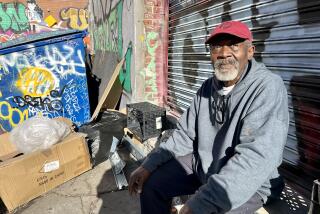Three Crucial Landings on the Staircase of Life : Poverty: A foothold at the right time can obviate the need for an entire ladder later on.
- Share via
Adolescence, midlife and old age are stages on life’s stairs where, if the railing is broken or missing, people have to fall all the way down to poverty before getting help. Remarkably, programs that help people overcome life crises are also effective in preventing or alleviating poverty.
Three stories show how people teetering on the edge may recover with help at the crucial time.
* Claribel was forced to grow up at the age of 17 when her stepfather shot her mother to death and then killed himself in front of her 4-year-old brother. A month later, Claribel and her three younger siblings were homeless in Dover, N.J.
A counselor at Dover High, where Claribel was enrolled, offered emotional and economic assistance. This timely help was not by accident. New Jersey has pioneered a program called School-Based Youth Services, which provides access to a comprehensive network of assistance for teen-agers and their families.
The program gave Claribel counseling and helped her find an apartment, furniture, clothing and counseling for the brother who had witnessed the killings. Through the program, Claribel managed to get legal custody of her siblings. She has graduated from high school and is working part time and attending junior college.
The state provides school districts with $200 per student per year for School-Based Youth Services. Putting Claribel and her siblings in foster care for just one year would have cost taxpayers at least $40,000.
* The midlife crisis of Lee Sliwinski is an archetypal story of America’s passage from prosperous innocence to hard experience in the post-industrial age. Lee was born in 1941, the year Japan attacked Pearl Harbor, and he grew up in Wyandotte, Mich., a blue-collar suburb of Detroit that would later be devastated by the Japanese auto invasion. When he graduated from high school in 1959, Lee got a $75-a-week job at the steelyard where his father worked and thought he was set for life.
Thirty-odd years later, Lee stands in front of the padlocked Firestone Steel plant, one of 20 closed plants along the Detroit River. Lee looks a decade older than his 52 years; his hands are empty.
What happened to Lee and the smokestack industries of the Rust Belt in the 1980s is now happening to defense workers in Southern California in the 1990s. We haven’t learned from the mistakes of Detroit; we are repeating them. This is unfortunate, because Detroit has positive lessons to teach Los Angeles. One hopeful program in the Detroit area, the Job Connection, goes to great lengths to help displaced and chronically unemployed workers retrain and find new careers.
The Job Connection is funded by the federal government and private enterprise. When a plant is shutting down, the Job Connection swings into action, sending job counselors to assist workers before they are unemployed. After 18 plant closures in the area, the Job Connection has helped nearly 1,100 workers make the transition to employment or education.
* Elderly Americans who supported themselves all their lives fear losing their autonomy in nursing homes. This fear became reality for Christina Halkett 17 years ago.
A childless widow who had suffered a stroke, she could no longer live alone. Entering the nursing home in Dorchester, Mass., was like entering a tomb. A pall of silence hung over the place. Christina knew no one, and looked forward to laughing and talking with her new neighbors at mealtime. When she entered the dining room for the first time, she was stunned by the silence. Struggling to control her half-paralyzed limbs, Christina pulled herself up to her feet and, in a quavering voice, asked, “Isn’t this supposed to be a home and we’re all here together?” A cafeteria worker hissed at her to sit down, but Christina held her ground, raising a cri de coeur against the institution’s habit of silence.
Christina has refused to be silenced. She joined an organization called LIFE--Living Is for the Elderly, which lobbies for seniors’ rights from within nursing homes. Her lilting voice with its Scottish burr speaking up for the rights of nursing-home residents has been heard all the way to the governor’s office.
Christina is now 95. “People need help at every age,” she says.
Successful efforts to help people overcome life crises have basic things in common: They reach people before they fall, build self-confidence and help them recover and move forward. They form a railing up life’s stairs, which are becoming more rickety year by year.


